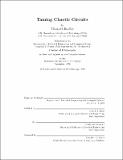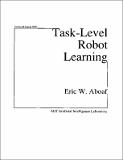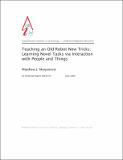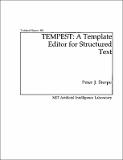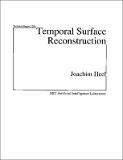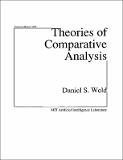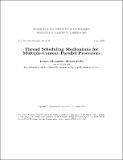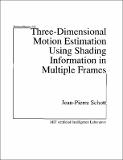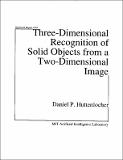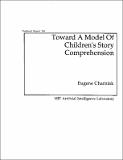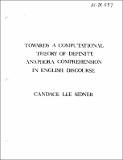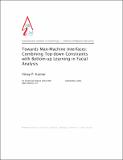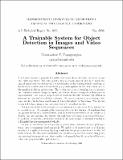Browsing AI Technical Reports (1964 - 2004) by Title
Now showing items 286-305 of 327
-
Taming Chaotic Circuits
(1992-09-01)Control algorithms that exploit chaotic behavior can vastly improve the performance of many practical and useful systems. The program Perfect Moment is built around a collection of such techniques. It autonomously ... -
Task-Level Robot Learning
(1988-08-01)We are investigating how to program robots so that they learn from experience. Our goal is to develop principled methods of learning that can improve a robot's performance of a wide range of dynamic tasks. We have ... -
Teaching an Old Robot New Tricks: Learning Novel Tasks via Interaction with People and Things
(2003-06-20)As AI has begun to reach out beyond its symbolic, objectivist roots into the embodied, experientialist realm, many projects are exploring different aspects of creating machines which interact with and respond to the world ... -
TEMPEST: A Template Editor for Structured Text
(1985-06-01)TEMPEST is a full-screen text editor that incorporates a structural paradigm in addition to the more traditional textual paradigm provided by most editors. While the textual paradigm treats the text as a sequence of ... -
Temporal Surface Reconstruction
(1991-05-01)This thesis investigates the problem of estimating the three-dimensional structure of a scene from a sequence of images. Structure information is recovered from images continuously using shading, motion or other visual ... -
Test Generation Guided Design for Testability
(1988-07-01)This thesis presents a new approach to building a design for testability (DFT) system. The system takes a digital circuit description, finds out the problems in testing it, and suggests circuit modifications to correct ... -
Theories of Comparative Analysis
(1988-05-01)Comparative analysis is the problem of predicting how a system will react to perturbations in its parameters, and why. For example, comparative analysis could be asked to explain why the period of an oscillating ... -
Theory of Handwriting
(1980-03-01)Handwriting production is viewed as a constrained modulation of an underlying oscillatory process. Coupled oscillations in horizontal and vertical directions produce letter forms, and when superimposed on a rightward ... -
A Theory of Quantitative Inference Applied to a Mechanical Design Compiler
(1989-01-01)This thesis presents the ideas underlying a computer program that takes as input a schematic of a mechanical or hydraulic power transmission system, plus specifications and a utility function, and returns catalog numbers ... -
Thread Scheduling Mechanisms for Multiple-Context Parallel Processors
(1995-06-01)Scheduling tasks to efficiently use the available processor resources is crucial to minimizing the runtime of applications on shared-memory parallel processors. One factor that contributes to poor processor utilization ... -
Three-Dimensional Correspondence
(1998-12-01)This paper describes the problem of three-dimensional object correspondence and presents an algorithm for matching two three-dimensional colored surfaces using polygon reduction and the minimization of an energy function. ... -
Three-Dimensional Motion Estimation Using Shading Information in Multiple Frames
(1989-09-01)A new formulation for recovering the structure and motion parameters of a moving patch using both motion and shading information is presented. It is based on a new differential constraint equation (FICE) that links the ... -
Three-Dimensional Recognition of Solid Objects from a Two-Dimensional Image
(1988-10-01)This thesis addresses the problem of recognizing solid objects in the three-dimensional world, using two-dimensional shape information extracted from a single image. Objects can be partly occluded and can occur in ... -
Time-Frequency Representations for Speech Signals
(1987-05-01)This work addresses two related questions. The first question is what joint time-frequency energy representations are most appropriate for auditory signals, in particular, for speech signals in sonorant regions. The ... -
Toward A Model Of Children's Story Comprehension
(1972-12-01)How does a person answer questions about children's stories? For example, consider 'Janet wanted Jack's paints. She looked at the picture he was painting and said 'Those paints make your picture look funny.' The ... -
Toward a Theory of Representation Design
(1989-05-01)This research is concerned with designing representations for analytical reasoning problems (of the sort found on the GRE and LSAT). These problems test the ability to draw logical conclusions. A computer program was ... -
Towards a Computational Theory of Definite Anaphora Comprehension in English Discourse
(1979-06-01)This report investigates the process of focussing as a description and explanation of the comprehension of certain anaphoric expressions in English discourse. The investigation centers on the interpretation of definite ... -
Towards Intelligent Structures: Active Control of Buckling
(1994-05-01)The buckling of compressively-loaded members is one of the most important factors limiting the overall strength and stability of a structure. I have developed novel techniques for using active control to wiggle a ... -
Towards Man-Machine Interfaces: Combining Top-down Constraints with Bottom-up Learning in Facial Analysis
(2002-09-01)This thesis proposes a methodology for the design of man-machine interfaces by combining top-down and bottom-up processes in vision. From a computational perspective, we propose that the scientific-cognitive question ... -
A Trainable System for Object Detection in Images and Video Sequences
(2000-05-01)This thesis presents a general, trainable system for object detection in static images and video sequences. The core system finds a certain class of objects in static images of completely unconstrained, cluttered scenes ...

